
Crotalaria is a genus of flowering plants in the legume family Fabaceae commonly known as rattlepods. The genus includes over 700 species of herbaceous plants and shrubs. Africa is the continent with the majority of Crotalaria species, which are mainly found in damp grassland, especially in floodplains, depressions and along edges of swamps and rivers, but also in deciduous bush land, roadsides and fields. Some species of Crotalaria are grown as ornamentals. The common name rattlepod or rattlebox is derived from the fact that the seeds become loose in the pod as they mature, and rattle when the pod is shaken. The name derives from the Ancient Greek κρόταλον, meaning "castanet", and is the same root as the name for the rattlesnakes (Crotalus).

Crotalaria longirostrata, the chipilín, is a perennial legume that is native to Central America. Other common names include chepil, chepilin, chipilin and longbeak rattlebox.
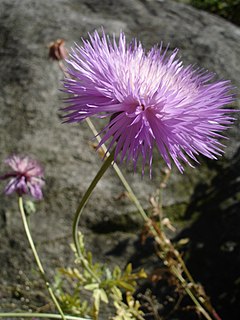
Amberboa moschata is a Southwest Asian species of plants in the sunflower family. It is native to Turkey, Iraq, Iran, and the Caucasus. It is also widely cultivated in many places as an ornamental, and is reportedly naturalized in parts of China and North America.

Pyrrolizidine alkaloids (PAs), sometimes referred to as necine bases, are a group of naturally occurring alkaloids based on the structure of pyrrolizidine. Pyrrolizidine alkaloids are produced by plants as a defense mechanism against insect herbivores. More than 660 PAs and PA N-oxides have been identified in over 6,000 plants, and about half of them exhibit hepatotoxicity. They are found frequently in plants in the Boraginaceae, Asteraceae, Orchidaceae and Fabaceae families; less frequently in the Convolvulaceae and Poaceae, and in at least one species in the Lamiaceae. It has been estimated that 3% of the world’s flowering plants contain pyrrolizidine alkaloids. Honey can contain pyrrolizidine alkaloids, as can grains, milk, offal and eggs. To date (2011), there is no international regulation of PAs in food, unlike those for herbs and medicines.

Crotalaria juncea, known as brown hemp, Indian hemp, Madras hemp, or sunn hemp, is a tropical Asian plant of the legume family (Fabaceae). It is generally considered to have originated in India.

Alepidea peduncularis is an edible perennial herb native to the montane grasslands of East and South Africa.
Prodromus Florae Novae Hollandiae et Insulae Van Diemen is a flora of Australia written by botanist Robert Brown and published in 1810. Often referred to as Prodromus Flora Novae Hollandiae, or by its standard botanical abbreviation Prodr. Fl. Nov. Holland., it was the first attempt at a survey of the Australian flora. It described over 2040 species, over half of which were published for the first time.

Galinsoga is a genus of flowering plants in the family Asteraceae. It is native to North and South America and the West Indies, and naturalized in Europe, Asia, Africa, and Australia.
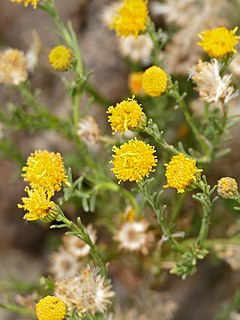
Pentzia is a genus of African plants in the chamomile tribe within the sunflower family. One species (P. incana) is naturalized in Australia and in the southwestern United States.

Meglutol is a hypolipidemic agent.
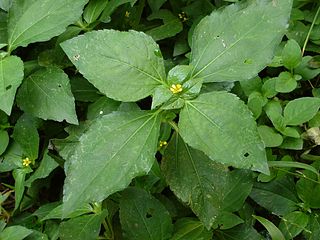
Synedrella is a genus of flowering plants in the sunflower family.
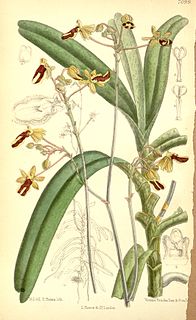
Cottonia is a monotypic genus of flowering plants from the orchid family, Orchidaceae: the only known species is Cottonia peduncularis. It is native to India and Sri Lanka. The genus was erected by Robert Wight and named after Major Frederick Cotton, an amateur botanist who served in the Madras Engineer Group and collected the species from Tellichery. A coloured illustration of the plant had been sent to Wight by Thomas C. Jerdon.

Crotalaria cunninghamii, also known as green birdflower, birdflower ratulpo, parrot pea or regal birdflower, is a plant of the legume family Fabaceae, named Crotalaria after the Greek word for rattle, because their seeds rattle, and cunninghamii after early 19th century botanist Allan Cunningham. Crotalaria cunninghamii is a short-lived perennial plant native to Australia and its habitat is the deserts, coastlands, drainage lines and sand dunes of the northern half of Western Australia and the Northern Territory. This habitat is semi-arid to temperate regions in well drained soils. Crotalaria cunninghamii blooms from January to April. It is pollinated by large bees and by honeyeaters. Crotalaria cunninghamii is known as the Mangarr plant to the Nyangumarta Warrarn indigenous group.

Crotalaria verrucosa, the blue rattlepod, is a species of flowering plant in the legume family, Fabaceae. This shrub belongs to the subfamily Faboideae. The herb found in Bangladesh, China, Cambodia, India, Indonesia, Laos, Malaysia, Myanmar, Nepal, Philippines, Sri Lanka, Thailand, Vietnam; Australasia and Africa and Americas regions.

Gagea peduncularis is a Mediterranean plant species in the lily family. It is native to Italy (Apulia), Greece, the Balkans, Turkey, Cyprus, and Libya.

Crotalaria retusa is a species of flowering plant in the legume family known by various common names including devil-bean, rattleweed, shack shack, and wedge-leaf rattlepod. It is poisonous to livestock, and contaminates human food. Its original native range is unclear, probably including tropical Asia, Africa and Australia. It has been introduced as a crop plant in many tropical areas and has escaped from cultivation to become a troublesome weed; it is listed as a noxious weed in several US states, Puerto Rico, the Virgin Islands, and is listed as an invasive weed in India, Cuba, and Cocos Island. Unlike some other species of Crotalaria, it is an annual plant.
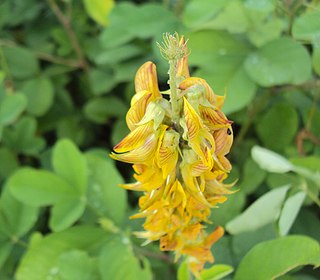
Crotalaria pallida, commonly known as the smooth crotalaria, is a species of flowering plant within the family Fabaceae.

Crotalaria sagittalis, known as arrowhead rattlebox or just rattlebox, is an annual wildflower native to the United States, Midwestern and Eastern states.
Escobedia is a genus of flowering plants belonging to the family Orobanchaceae.
















